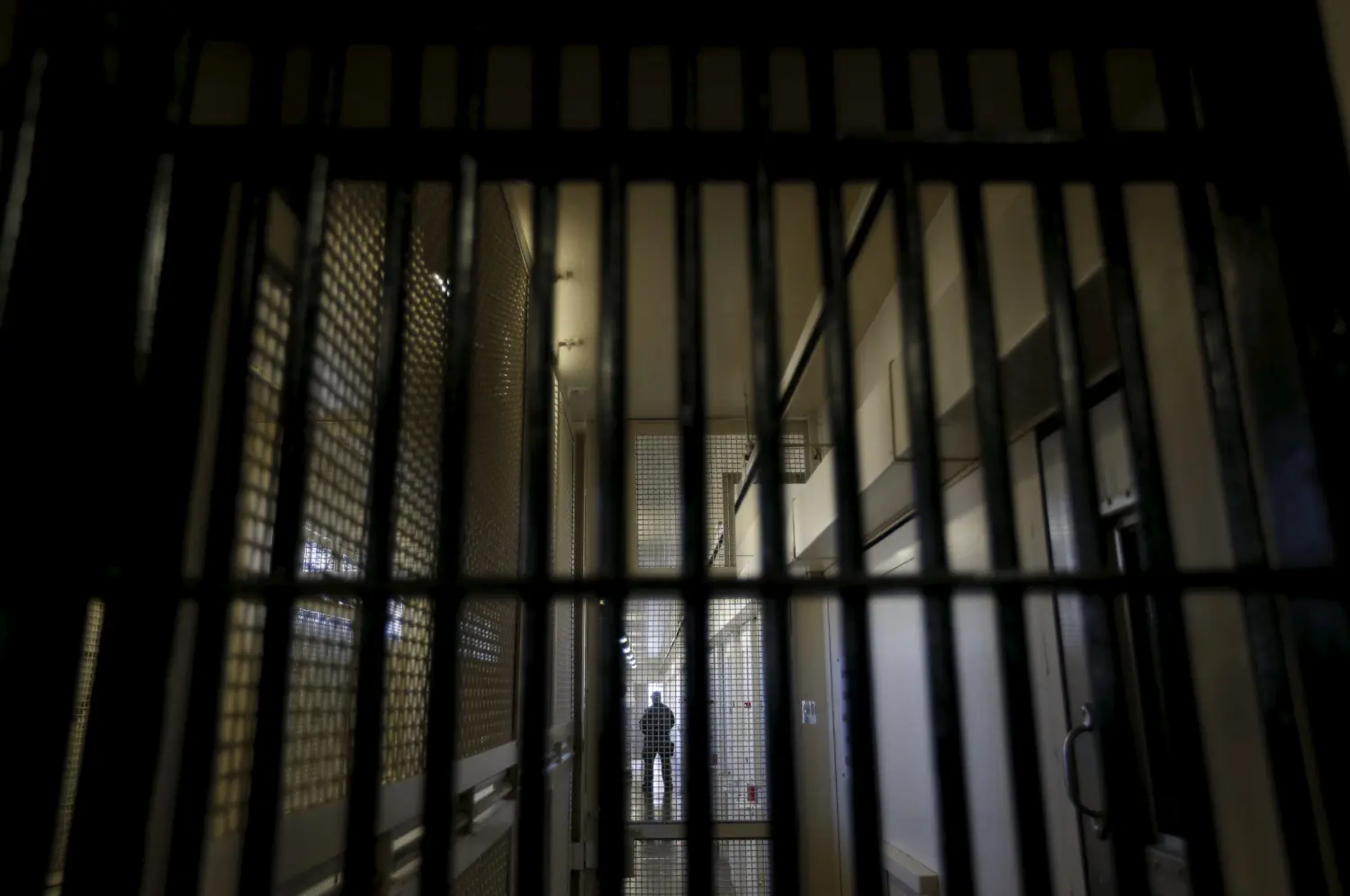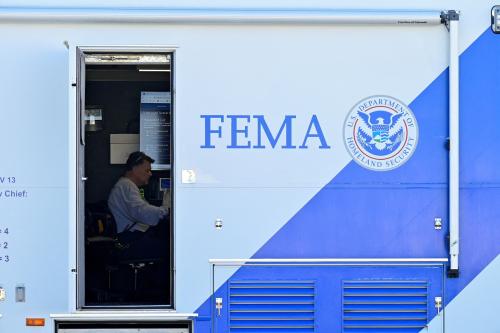The following brief is part of Brookings Big Ideas for America—an institution-wide initiative in which Brookings scholars have identified the biggest issues facing the country and provide ideas for how to address them. (Updated January 27, 2017)
In recent years, the future course of the American criminal justice system has come under immense scrutiny. The White House indicated that substantial reform would be a leading priority for President Obama’s last year in office, both chambers of Congress have seen legislation introduced and debated, Americans across the country have turned their passionate attention to the issue, and the subject was raised in all of the presidential and vice presidential debates in the 2016 campaign. At times, however, the passions of both citizens and lawmakers on this issue are fueled by incomplete, inaccurate, and insufficient data. For that reason, this chapter collects and compiles the best substantiated data on critical elements of the criminal justice system to provide an informed common framework for understanding the state of the system today, and the proposed reforms that will shape its future.
The Issues and Facts
Five critical elements of the criminal justice system—nationwide crime rates; prison population and buildup; the costs of incarceration; and individuals killed by police—are worth assessing and evaluating in greater detail.
Crime
Despite recent speculation about a nationwide crime surge, crime rates are near the lowest levels seen in decades.
Despite recent speculation about a nationwide crime surge,1 crime rates are near the lowest levels seen in decades. From 1980 to 2012, the most recent year for which comprehensive, nation-wide data is available, there has been a 35 percent drop in the violent crime rate (from 597 to 387 crimes per 100,000 citizens) and a 47 percent decrease in property crime rate (from 5,353 to 2,859 crimes per 100,000 citizens).2 From 1980 to 2008, homicide rates declined for blacks as well as for whites, with a significant uptick and subsequent decline in the early 1990s. The rate in homicide victimization for whites declined 49 percent (from 6.5 to 3.3 homicides per 100,000 citizens), and offense rate dropped 47 percent (from 6.4 to 3.4 homicides per 100,000 citizens). Parallel to this trend, the rate of black homicide victimization declined 58 percent (from 37.6 to 19.6 homicides per 100,000 citizens) and offense rate declined 50 percent (from 49.8 to 24.7 homicides per 100,000 citizens).3
While the nationwide arrest rate for all offenses decreased by 16 percent during this period, the arrest rate for drug crime increased by 93.4 percent.4 Drug sale/manufacturing arrests increased by 55 percent and drug possession arrests increased 104.5 percent.5 Arrest rates are not synonymous with rates of offenses; arrests reflect the frequency with which crimes are reported, police decisions regarding offenses on which they will concentrate their attention and resources, and the relative vulnerability of certain crimes to arrest.
The net decrease in nationwide crime coincides with the rapid buildup of the United State prison population. However, the relationship between decreased crime and increased incarceration is disputed. To understand historic decreases in crime and arrest rates, we must consider a number of complex social and political factors. Beyond increased incarceration, widely discussed hypotheses include:
Improved policing: Over the past two decades, new technology has permitted police to use data to target and reduce crime.6Waning demand for crack cocaine: As the demand for crack has waned, so too has the associated violence and addiction.7Shifting demographics: The average age of the U.S. population has increased, and age is inversely related to propensity to commit a crime.8The economy: Favorable economic conditions in the 1990s and 2000s, including low unemployment rates and increased consumer confidence, reduced some of the impetus for crime.9
Prison Buildup
Over the past thirty years, the United States’ prison population has increased by 340 percent.10 The incarcerated population is a function of the number of offenders admitted to and released from prison. For decades, the number of prisoners admitted greatly outpaced the number released, driving a surge in the population of incarcerated individuals at the local, state, and federal levels.11 As of 2013, the latest year for which comprehensive nationwide data is available, the United States incarcerated 2,220,300 individuals.12
For decades, the number of prisoners admitted greatly outpaced the number released, driving a surge in the population of incarcerated individuals at the local, state, and federal levels.
There is vigorous scholarly debate on the causes and correlates of the burgeoning prison population.13 Increased admissions can be attributed to a variety of factors including increased rates of investigation, prosecution, sentencing, and admission.14 Decreased releases are due to factors such as increased sentence length and decreased eligibility for parole.15
Many of these factors are the result of public policy choices, which vary with the nation’s political mood. In the mid-1970s, for instance, reformers championed statutory sentencing standards, including mandatory minimums, to address “racial and other unwarranted disparities” in the criminal justice system.16 A decade later, responding to surging crime rates and widespread concern about public safety, state and federal lawmakers enacted tough new measures—mandatory minimum laws, three strikes laws, and life in prison without the possibility of parole, for instance—to target violent and drug offenders.17
Prison Composition
In 2014, the state prison population was 6.4 times that of the federal prison population.18 In state prisons, violent offenders comprise the majority (53 percent) of sentenced prisoners, while drug offenders make up just 16 percent of the population.19 In federal prisons, drug offenders make up the majority (50 percent) of the population, while violent offenders constitute just 7 percent of the population.20
Of those drug offenders in federal prison, 95.1 percent can be classified as traffickers, while just 0.8 percent of federal drug offenders are imprisoned for unlawful possession.21 However, the drug offender category is quite broad—it includes offenses ranging in culpability from drug mule to high-level supplier/ importer. Fewer than half of federal drug offenders (41.4 percent) are involved with the organization and/ or management of the drug trade. Indeed, the majority (56.7 percent) of offenders played a lesser and more replaceable role in drug distribution.22
Characteristics of the Prison Population
The proportion of incarcerated women has grown at almost twice the rate of men since the 1990s.
Although men comprise the majority (93.4 percent) of the U.S. incarcerated population, the proportion of incarcerated women has grown at almost twice the rate of men since the 1990s.23 The underlying circumstances contributing to the dramatic increase in women’s incarceration for drug offenses have yet to be thoroughly examined and addressed by researchers or policy makers.24
The United States incarcerates a disproportionate number of black and Latino individuals relative to their composition in the U.S. population.25 The causes and correlates of this racial discrepancy in the criminal justice system are manifold. Studies suggest that a variety of factors contribute to racial disparities in criminal justice involvement, including law enforcement practices, neighborhood crime rates, offenders’ socioeconomic status, and state and federal-level sentencing policy.26
Most (76.6 percent) offenders recidivate within five years of being released from prison, a striking trend observable across demographic categories.27 Cyclical incarceration imposes tremendous costs on individuals, families, and communities.28 Upon being released from prison, an individual faces legal barriers to employment, housing, and voting.29 Families with incarcerated loved ones suffer financial losses due to lost income. Studies show that children with incarcerated parents exhibit more negative behavioral,30 academic,31 and emotional outcomes.32 These so-called “collateral consequences” compound and destabilize community support systems.
Cost of Incarceration
In 2010, total corrections expenditures totaled $80 billion—a 350 percent increase from 1980 (in real terms).33 Consistent with the distribution of the prison population, the majority of the expenditure occurs at the local and state, rather than federal, levels.34
Individuals Killed by Police
987 individuals were shot and killed by police officers in 2015.35 The vast majority (78 percent) of victims were armed with a deadly weapon: only 10 percent were killed while unarmed.36 50 percent of the individuals killed by police were white, but police killed a disproportionate number of minority individuals relative to the racial composition of the U.S. population.37 While the data are not inconsistent with racial bias in police shootings, the best available evidence is too limited to allow us to substantiate claims of racial bias.
The majority of police killings do not take place in major metropolitan areas.38 For example, only 2 out of the 15 fatal shootings in Maryland occurred in Baltimore.39 Chicago is a notable exception to this pattern; 9 out of the 21 (43 percent) of police shootings in Illinois occurred in Chicago.40
Reform efforts and options
In our hyperpolarized system, signs of emerging agreement across party lines are hard to come by. Criminal justice reform may be one of the few exceptions. During much of 2016, Democrats and Republicans in both the House and Senate have engaged in serious discussions about legislation that could command broad support.
This effort rests on two widely held premises. First, although the tough steps taken in response to the crime surge of the 1980s and 1990s were justified in principle, some of them went too far, generating unanticipated consequences that stand in need of correction. Second,
A revolving-door system in which three-quarters of all felons commit new crimes within five years of their release guarantees excessive rates of incarceration and criminal justice expenditures as far as the eye can see.
The House and Senate bills, which emerged from their respective judiciary committees before stalling mid-year, would attack both these problem. With regard to what Senator Chuck Grassley (R-IA), the chairman of the Senate Judiciary Committee, has called “legitimate over-incarceration concerns,” the reform proposals would reduce sentences for low-level drug offenders, the largest single category of federal felons, as well as for weapons offenders, the second-largest category. Some law-makers see this as the leading edge of a broader reconsideration of “mandatory minimum sentences,” a strategy adopted in the 1990s to prevent lenient judges from allowing convicted criminals to return to the streets too quickly.
Regarding recidivism, the bi-partisan Charles Colson Task Force on Federal Correction urged Congress to give the Federal Bureau of Prisons the authority and the resources it needs to deliver evidence-based educational and job-related training to inmates, especially those at the greatest risk of re-offending. Here again, legislation moved forward in both the House and the Senate before hitting road-blocks.
It is possible that the Congress will return to these topics during the post-election “lame-duck” session and reach agreement on final legislation. If not, the next president would have the opportunity to build on the progress made this year and score an early bipartisan win.
Although this would be a good start, it would not be enough. To reverse the revolving door in and out of prisons, for example, localities backed by the federal government would have to set up comprehensive re-integration regimes for recently released inmates, including much better linkages between these individuals and potential employers. The current system of parole supervision is not up to this task or—put more accurately—does not really try to do it.
Here as elsewhere, the proverbial devil is in the details. Some reformers endorse a proposal called “ban the box,” which would prohibit employers from inquiring into a job applicant’s criminal justice history. Skeptics point to evidence that programs along these lines have led to increased discrimination along lines of race and ethnicity: If employers can’t get information about individuals, they go with the demographic odds. It will take patient experimentation and honest commitment to evidence-based policy making to resolve such issues.
This leaves the thorniest issue of all—relations between local police forces and communities of color. In recent years, high-profile shootings of young minority males have led to protests and social unrest in numerous communities and—in a handful of instances—lethal retaliation against police officers. These events have divided public opinion along racial and ethnic lines as well, with whites far less likely than African Americans to see unwarranted and discriminatory police conduct.
But even here, there are signs of hope. Earlier this year, the chair and ranking member of the House Judiciary Committee came together to call for “urgent congressional attention” to address the crisis of confidence between the police and the communities they have pledged to protect. At the same time, they recognized that quantitatively as well as politically, the bulk of the action must take place at the state and local level. While federal legislation may be helpful in some instances, individual communities have different histories and needs. Police-community relations may be deeply vexed in Chicago, Baltimore, and Baton Rouge, for example, but there is no reason to believe that steps that work in one of these communities would be equally effective in the others.
These are troubled waters, obviously, and the next president will have to navigate them carefully. Nonetheless, there are opportunities for bi-partisan leadership that did not exist even a few years ago, and the new occupant of the Oval Office would be well-advised to seize them.
-
Footnotes
- Mariano Castillo, Is a New Crime Wave on the Horizon?, CNN, June 4 2015, available at http://www.cnn. com/2015/06/02/us/crime-in-america; Aamer Madhani, Several Big U.S. Cities See Murder Rates Surge, USA Today, July 10, 2015, available at http://www.usatoday.com/story/news/2015/07/09/us-cities-murder-surge-2015/29879091, Martin Kaste, Nationwide Crime Spike has Law Enforcement Retooling Its Approach, NPR, Oct. 10, 2015, available at http://www.npr.org/2015/07/01/418555852/nationwide-crime-spike-has-law-enforcement-retooling-their-approach; Monica Davey, Murder Rates Rising Sharply in Many U.S. Cities, N.Y. Times, Aug. 31, 2015, available at http://www. nytimes.com/2015/09/01/us/murder-rates-rising-sharply-in-many-us-cities.html.
- Brookings analysis of, “Estimated crime in United States-Total,” Generated using the Uniform Crime Reporting Data Tool, Federal Bureau of Investigation, http://www.ucrdatatool.gov/Search/Crime/State/RunCrimeStatebyState.cfm.
- Brookings analysis of Alexia Cooper and Erica L. Smith, “Homicide Trends in the United States, 1980-2008,” Bureau of Justice Statistics, November 2011, p. 11-13, http://www.bjs.gov/content/pub/pdf/htus8008.pdf.
- Brookings analysis of “Arrests in the United States, 1980-2012,” Dataset generated from the Arrest Data Analysis Tool, Bureau of Justice Statistics, Accessed January 4, 2016, http://www.bjs.gov/index.cfm?ty=datool&surl=/arrests/index.cfm#.
- Brookings analysis of, “Estimated crime in United States-Total,” Generated using the Uniform Crime Reporting Data Tool, Federal Bureau of Investigation, http://www.ucrdatatool.gov/Search/Crime/State/RunCrimeStatebyState.cfm.
- Travis, Jeremy and Waul, Michelle, Reflections on the Crime Decline: Lessons for the Future? (Washington: Urban Institute, August 2002), http://www.urban.org/uploadedpdf/410546_crimedecline.pdf.
- Blumstein, Alfred and Wallman, Joel, The Crime Drop in America (New York: Cambridge University Press, 2005).
- Blumstein, Alfred and Rosenfeld, Richard, “Factors Contributing to U.S. Crime Trends,” in Understanding Crime Trends: Workshop Report, eds. Arthur S. Goldberger and Richard Rosenfeld (Washington: National Academies Press, 2008), 13, http://www.nap.edu/openbook.php?record_id=12472&page=13.
- Zimring, Franklin E., The Great American Crime Decline (New York: Oxford University Press, November 2006).
- “Table: Estimated number of persons under correctional supervision in the United States, 1980-2013,” Key Statistics: Total Correctional Population, Bureau of Justice Statistics. Accessed January 4, 2016, http://www.bjs.gov/index.cfm?ty=kfdetail&iid=487.
- Pfaff, John, “The Myths and Realities of Correctional Severity: Evidence from the National Corrections Reporting Program on Sentencing Practices,” American Law and Economics Review, Fall 2011, 13 (2), http://aler.oxfordjournals.org/content/13/2/491.short, pp. 491-531.
- Brookings analysis of “Table: Estimated number of persons under correctional supervision in the United States, 1980-2013,” Key Statistics: Total Correctional Population, Bureau of Justice Statistics. Accessed January 4, 2016, http://www.bjs.gov/index.cfm?ty=kfdetail&iid=487 .
- See: “Prison Time Surges for Federal Inmates,” The Pew Charitable Trusts, November 2015, http://www.pewtrusts.org/en/research-and-analysis/issue-briefs/2015/11/prison-time-surges-for-federal-inmates.; Mallik-Kane Kamala, Parthasarathy Barbara, and Adams, William, “Examining Growth in the Federal Prison Population, 1998 to 2010,” The Urban Institute, 2012, http://www.urban.org/sites/default/files/alfresco/publication-pdfs/412720-Examining-Growth-in-the-Federal-Prison-Population–to–.PDF.; Raphael, Steven and Stoll, Michael, “Why Are So Many Americans in Prison?,” Social Foreces, March 2016, 94 (3), http://sf.oxfordjournals.org/content/early/2014/05/14/sf.sou052.full.pdf+html. ; Pfaff, John, “The Myths and Realities of Correctional Severity: Evidence from the National Corrects Reporting Program on Sentencing Practices,” American Law and Economics Review, Fall 2011, 13 (2), pp. 491-531, http://aler.oxfordjournals.org/content/13/2/491.full.pdf+html; Pfaff, John, The Causes of Growth in Prison Admission and Population,” Social Science Research Network, July 12, 2011, http://dx.doi.org/10.2139/ssrn.1884674.
- See: Mallik-Kane, Kamala, Parthasarathy, Barbara, and Adams, William, “Examining Growth in the Federal Prison Population, 1998 to 2010,” The Urban Institute, 2012, http://www.urban.org/sites/default/files/alfresco/publication-pdfs/412720-Examining-Growth-in-the-Federal-Prison-Population–to–.PDF. ; Pfaff, John, The Causes of Growth in Prison Admission and Population,” Social Science Research Network, July 12, 2011, http://dx.doi.org/10.2139/ssrn.1884674. ; Pfaff, John F., Escaping from the Standard Story: Why the Conventional Wisdom on Prison Growth is Wrong, and Where We Can Go from Here, March 25, 2014, Federal Sentencing Reporter, Forthcoming; Fordham Law Legal Studies Research Paper No. 2414596. Available at SSRN: http://ssrn.com/abstract=2414596.; “Drivers of Growth in the Federal Prison Population,” The Charles Colson Task Force on Federal Corrections and The Urban Institute, March 2015, http://www.urban.org/sites/default/files/alfresco/publication-pdfs/2000141-Drivers-of-Growth-in-the-Federal-Prison-Population.pdf.
- Mallik-Kane, Kamala, Parthasarathy, Barbara, and Adams, William, “Examining Growth in the Federal Prison Population, 1998 to 2010,” The Urban Institute, 2012, http://www.urban.org/sites/default/files/alfresco/publication-pdfs/412720-Examining-Growth-in-the-Federal-Prison-Population–to–.PDF. ; Pfaff, John, The Causes of Growth in Prison Admission and Population,” Social Science Research Network, July 12, 2011, http://dx.doi.org/10.2139/ssrn.1884674.
- National Research Council, The Growth of Incarceration in the United States: Exploring Causes and Consequences, Committee on Causes and Consequences of High Rates of Incarceration, J. Travis, B. Western, and S. Redburn, Editors. Committee on Law and Justice, Division of Behavioral and Social Sciences and Education, Washington, DC, 2014, The National Academies Press, pp.71-74.
- National Research Council, The Growth of Incarceration in the United States: Exploring Causes and Consequences, Committee on Causes and Consequences of High Rates of Incarceration, J. Travis, B. Western, and S. Redburn, Editors. Committee on Law and Justice, Division of Behavioral and Social Sciences and Education, Washington, DC, 2014, The National Academies Press, pp.71-74.
- Brookings analysis of Carson, Ann, “Prisoners in 2014,” Bureau of Justice Statistics, September 2015, http://www.bjs.gov/content/pub/pdf/p14.pdf. p. 3, and Minton, Todd, and Zeng, Zhen, “Jail Inmates at Midyear 2014,” Bureau of Justice Statistics, June 2015, p. 3 http://www.bjs.gov/content/pub/pdf/jim14.pdf.
- Carson, Ann, “Prisoners in 2014,” Table 11, Estimated percent of sentenced prisoners under state jurisdiction, by offense, sex, race, and Hispanic origin, December 31, 2013, Bureau of Justice Statistics, p. 16 http://www.bjs.gov/content/pub/pdf/p14.pdf.
- Carson, Ann, “Prisoners in 2014,” Table 12, Estimated percent of sentenced prisoners under federal correctional authority, by most serious offense, sex, race, and Hispanic origin, September 30, 2014, Bureau of Justice Statistics, p. 17 http://www.bjs.gov/content/pub/pdf/p14.pdf.
- Galston, William and McElvein, Elizabeth, “Criminal justice reform: the facts about federal drug offenders,” The Brookings Institution, February 13, 2016, https://www.brookings.edu/blogs/fixgov/posts/2016/02/13-criminal-justice-reform-galston-mcelvein.
- Galston, William and McElvein, Elizabeth, “Criminal justice reform: the facts about federal drug offenders,” The Brookings Institution, February 13, 2016, https://www.brookings.edu/blogs/fixgov/posts/2016/02/13-criminal-justice-reform-galston-mcelvein.
- Freudenberg, N. “Adverse Effects of US Jail and Prison Policies on the Health and Well-Being of Women of Color.” American Journal of Public Health: 1895-899, p. 1895
- Caught in the Net: The Impact of Drug Policies on Women and Families,” The American Civil Liberties Union, Break the Chains, and Brennan Center for Justice at NYU, 2005, Executive Summary. https://www.aclu.org/caught-net-impact-drug-policies-women-and-families.
- Brookings Analysis of Guerino, Paul, Harrison, Paige, and Sabol, William, “Prisoners in 2010,” Appendix table 12, Estimated number of sentenced prisoners under state and federal jurisdiction, by sex, race, and Hispanic origin, December 31, 2000–2010, Bureau of Justice Statistics, December 2011, p. 26 http://www.bjs.gov/content/pub/pdf/p10.pdf
- “Reducing Racial Disparity in the Criminal Justice System: A Manual for Practitioners and Policymakers,” The Sentencing Project, Vol. 2, 2008, p. 5.
- Durose, Matthew R., Cooper, Alexia D., Snyder, Howard D., “Recidivism of Prisoners Released in 30 States in 2005: Patterns from 2005 to 2010”, Bureau of Justice Statistics, April 2014, http://www.bjs.gov/content/pub/pdf/rprts05p0510.pdf
- “Transforming Prisons, Restoring Lives: Final Recommendations of the Charles Colson Task Force on Federal Corrections,” Charles Colson Task Force on Federal Corrections, January 2015, http://colsontaskforce.org/final-recommendations/Colson-Task-Force-Final-Recommendations-January-2016.pdf, p. 15.
- “Transforming Prisons, Restoring Lives: Final Recommendations of the Charles Colson Task Force on Federal Corrections,” Charles Colson Task Force on Federal Corrections, January 2015, http://colsontaskforce.org/final-recommendations/Colson-Task-Force-Final-Recommendations-January-2016.pdf, p. 15.
- Murray, Joseph, David P. Farrington, and Ivana Sekol. “Children’s Antisocial Behavior, Mental Health, Drug Use, and Educational Performance after Parental Incarceration: A Systematic Review and Meta-analysis.” Psychological Bulletin 138, no. 2 (2012): 175-210.
- Parke, Ross D., and K. Alison Clarke-Stewart. 2003. “The Effects of Parental Incarceration on Children:Perspectives, Promises and Policies.” In Prisoners Once Removed, edited by Jeremy Travis and Michelle Waul,189–232. Washington, DC: Urban Institute Press.
- Parke, Ross D., and K. Alison Clarke-Stewart. 2003. “The Effects of Parental Incarceration on Children: Perspectives, Promises and Policies.” In Prisoners Once Removed, edited by Jeremy Travis and Michelle Waul,189–232. Washington, DC: Urban Institute Press.
- Kearney, Melissa, et. al., “Ten Economic Facts about Crime and Incarceration in the United States,” The Hamilton Project, May 2014, https://www.brookings.edu/~/media/research/files/papers/2014/05/01-crime-facts/v8_thp_10crimefacts.pdf ,p. 13.
- Kearney, Melissa, et. al., “Ten Economic Facts about Crime and Incarceration in the United States,” The Hamilton Project, May 2014, https://www.brookings.edu/~/media/research/files/papers/2014/05/01-crime-facts/v8_thp_10crimefacts.pdf, p. 13.
- Brookings analysis of Tate, Julie, Jenkins, Jennifer, Kindy, Kimberly, Lowery, Wesley, Alexander, Keith and Rich, “Investigation: People Shot and Killed by Police This Year,” The Washington Post, Accessed January 11, 2016, https://www.washingtonpost.com/graphics/national/police-shootings/.
- Brookings analysis of Tate, Julie, Jenkins, Jennifer, Kindy, Kimberly, Lowery, Wesley, Alexander, Keith and Rich, “Investigation: People Shot and Killed by Police This Year,” The Washington Post, Accessed January 11, 2016, https://www.washingtonpost.com/graphics/national/police-shootings/.
- Brookings analysis of Tate, Julie, Jenkins, Jennifer, Kindy, Kimberly, Lowery, Wesley, Alexander, Keith and Rich, “Investigation: People Shot and Killed by Police This Year,” The Washington Post, Accessed January 11, 2016, https://www.washingtonpost.com/graphics/national/police-shootings/.
- Brookings analysis of Tate, Julie, Jenkins, Jennifer, Kindy, Kimberly, Lowery, Wesley, Alexander, Keith and Rich, “Investigation: People Shot and Killed by Police This Year,” The Washington Post, Accessed January 11, 2016, https://www.washingtonpost.com/graphics/national/police-shootings/.
- Brookings analysis of Tate, Julie, Jenkins, Jennifer, Kindy, Kimberly, Lowery, Wesley, Alexander, Keith and Rich, “Investigation: People Shot and Killed by Police This Year,” The Washington Post, Accessed January 11, 2016, https://www.washingtonpost.com/graphics/national/police-shootings/.
- Brookings analysis of Tate, Julie, Jenkins, Jennifer, Kindy, Kimberly, Lowery, Wesley, Alexander, Keith and Rich, “Investigation: People Shot and Killed by Police This Year,” The Washington Post, Accessed January 11, 2016, https://www.washingtonpost.com/graphics/national/police-shootings/.
The Brookings Institution is committed to quality, independence, and impact.
We are supported by a diverse array of funders. In line with our values and policies, each Brookings publication represents the sole views of its author(s).







